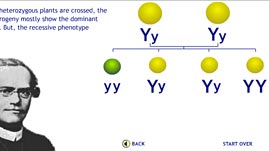Teachers' Domain - Digital Media for the Classroom and Professional Development
User: Preview

Source: Cold Spring Harbor Laboratory, Dolan DNA Learning Center
Using several animated sequences, this interactive activity adapted from the Dolan DNA Learning Center demonstrates the principle of dominance, which is fundamental to modern genetics. By crossing two pea plants, each pure-bred for a given trait like pea color, we learn why only the dominant trait—in this case, yellow pea color—appears in any and all offspring. We also learn why some offspring in subsequent generations exhibit the recessive trait—green—even though this may not have been apparent in the previous generation.
Over the course of eight years, beginning in 1856, an amateur scientist and Augustinian monk named Gregor Mendel crossed, or mated, common pea plants he grew in his garden. He crossed long-stemmed plants with short-stemmed plants, plants that bore round peas with those that bore wrinkled ones, and plants with purple flowers with those with white flowers. By crossing subsequent generations of offspring, he was able to observe just what happened to certain physical traits over time.
Even though Mendel's work went largely unnoticed in his lifetime, he introduced the seminal idea that traits are determined by paired units that he called "factors," now called "genes." He also proposed three principles that are fundamental to modern genetics. The first is the principle of dominance.
Mendel observed that crossing parent plants—one with green peas, the other with yellow—produced offspring that were always either green or yellow, and not a blend, which is what the scientific community at the time contended should happen. He also found that traits appeared with a predictable 3-to-1 frequency. Mendel called the more common trait "dominant" and the less common one "recessive."
Because traits did not blend, Mendel concluded that if either parent contributed one dominant allele, or part of a gene pair, the offspring's physical appearance, or phenotype, would reflect that of the dominant trait—even if its genetic makeup, or genotype, contained the recessive trait. Thus, yellow peas would appear with greater frequency than green ones because yellow is the dominant trait for pea color. (Note: The terms allele, phenotype, and genotype were not coined until the early 1900s.)
Interestingly, Mendel's work demonstrated that even if a trait was not evident in an offspring's phenotype, it could still be passed on through subsequent generations. When a hybrid parent—one that has a genotype consisting of one dominant and one recessive gene (we'll call this Yy)—crosses with another hybrid parent (also Yy), the chances are three in four that an offspring will display the dominant trait. This is because both YY and Yy genotypes exhibit the dominant trait. But there is also a one-in-four chance that an offspring will be yy and instead display the recessive trait.
 Loading Standards
Loading Standards Teachers' Domain is proud to be a Pathways portal to the National Science Digital Library.
Teachers' Domain is proud to be a Pathways portal to the National Science Digital Library.
